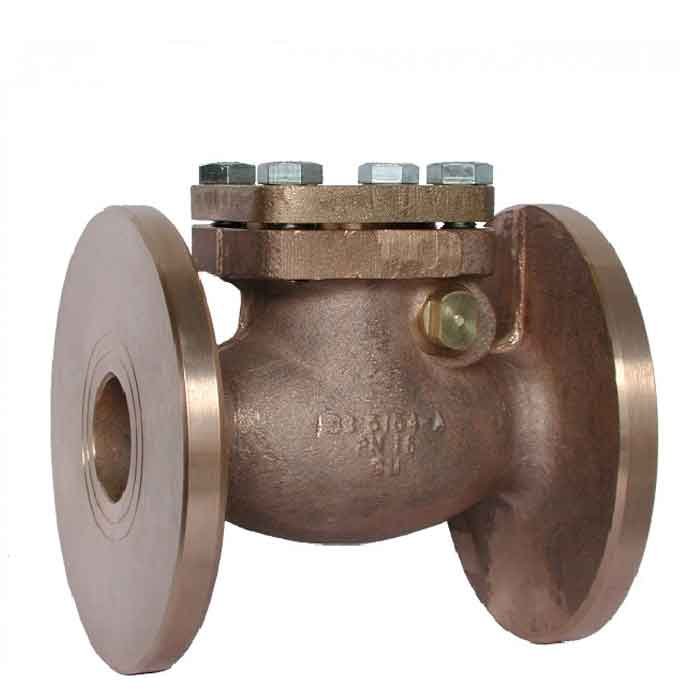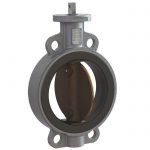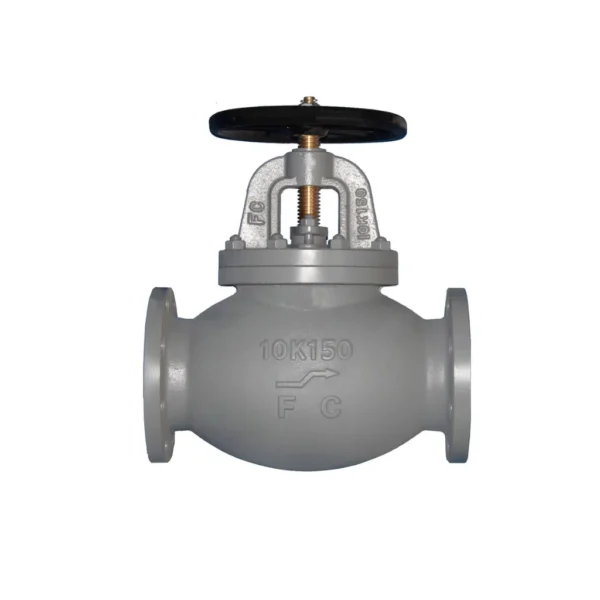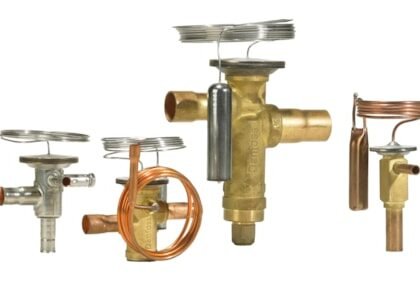A marine check valve, also known as a non-return valve or one-way valve, is a critical component in a ship’s piping system designed to automatically prevent the backflow of a fluid. Its operation is entirely passive, meaning it does not require an external handwheel, actuator, or human intervention to function.2 It opens and closes based on the pressure of the fluid flowing through the pipe.
Working Principle and Design
A check valve’s internal mechanism allows fluid to flow in only one direction.
- Forward Flow: When the pressure of the fluid in the forward direction exceeds the pressure on the outlet side, it pushes open a disc, flap, or ball, allowing the fluid to pass through the valve.
- Reverse Flow: If the pressure on the outlet side becomes higher than the inlet pressure, or if the flow stops, the disc or flap is pushed back against its seat, closing the valve and preventing any backflow.
This passive operation makes check valves an essential safety device for protecting pumps and ensuring the integrity of various fluid systems on board.
Main Types of Check Valves
There are several common types of check valves, each with a different internal mechanism suitable for specific applications:
- Swing Check Valve: The most common type. It features a disc that swings on a hinge or trunnion. Forward flow pushes the disc open, and reverse flow pushes it closed against the seat. They are best suited for low-velocity and low-pressure drop applications.
- Lift Check Valve: This valve has a disc or piston that lifts vertically off its seat under forward flow. When the flow stops or reverses, the disc is pushed back down onto the seat by gravity and back-pressure. They are often used in high-pressure or high-velocity systems like steam or water lines.
- Piston Check Valve: A variation of the lift check valve where a piston with a dashpot (a damping mechanism) is used to prevent the disc from “slamming” shut, which can cause water hammer.
- Spring-Loaded Check Valve: A spring holds the disc against the seat, requiring a certain amount of forward pressure to open the valve. The spring ensures a quick, positive closure, which is also effective against water hammer.
- Dual Plate Check Valve (Silent Check Valve): This type uses two D-shaped plates that are hinged together and held closed by a spring. They are designed to close rapidly and quietly to eliminate “water hammer” noise.
Applications and Materials
Check valves are used in any system where backflow could cause damage or malfunction.
- Common Applications on a Ship:
- Pump Discharge Lines: Prevents fluid from flowing back into a pump and damaging the impeller.
- Bilge and Ballast Systems: Prevents water from one compartment from flowing into another.
- Boiler Feed Water Lines: Prevents boiler water from flowing back into the pump and feed tank.
- Fire Fighting Systems: Prevents water from draining back into the pump from the fire mains.
- Materials: They are made from the same materials as other marine valves to match the system’s fluid, pressure, and temperature. These include bronze, cast iron, cast steel, and stainless steel.
Maintenance and Common Issues
Check valves require inspection to ensure their internal components are free to move.
- Common Issues:
- Leaking: The most common problem is leaking due to a worn seat, a damaged disc, or foreign debris caught on the seating surface.
- Slamming: A noisy closure of the valve can cause water hammer, which can damage pipes and other components.
- Failure to Open/Close: A broken hinge pin, a stuck disc, or a weak spring can prevent the valve from functioning correctly.
Spare Parts
A vessel’s spares inventory for check valves should include:
- Disc/Flap: A new disc or flap is the most critical spare, as this is the part that typically wears out or becomes damaged.
- Hinge Pin: For swing check valves.
- Spring: For spring-loaded check valves.
- Gaskets: For the body-to-bonnet joint.
- Bolts and Nuts: For assembly.
Check valves are a simple yet vital passive safety component, ensuring the reliable and safe operation of a ship’s extensive piping systems.
We offer an extensive range of marine engine brands and their associated spare parts, providing comprehensive solutions for both main propulsion and auxiliary power needs across diverse vessel types. Our supply capability covers various generations and models, ensuring support for a wide array of marine applications.
Featured Brands and Engine Series/Models:
SULZER:
- Two-Stroke Engines:
- RD/RND Series: RD68, RND76, RND76M, RND90, RND90M (Classic large-bore, low-speed engines, still in operation).
- RLA/RLB Series: RLA(B)56, RLA(B)66, RLA(B)76, RLB90 (Developed two-stroke designs).
- RTA/RT-Flex Series: RTA38, RTA48(T), RTA52, RTA58, RTA62, RTA72, RTA76, RTA84, RTA84M, RTA84C, RTA96 (Modern, fuel-efficient, electronically controlled two-stroke engines).
- Four-Stroke Engines:
- Z Series: ZL40/48, 16ZAV40S (Medium-speed engines).
- RF Series: RF44, RF56 (Often used for auxiliary power or generator sets).
- TAD Series: TAD36, TAD48 (For specific applications).
MAN (including pre and post-MAN B&W models):
- Two-Stroke Engines (KZ, KSZ, K, L, S, MC/MC-C, ME/ME-C): 40/54A, 52/90N, 57/80C, KZ57/80F, KSZ70/125, KSZ78/155, 90/160A, 52/55L, 58/64, 90/190C, L60/105E, 70/120E, 70/125C, L, KSZ78/155A, KSZ70/125B, L52/55A, 40/45 (A broad spectrum covering main propulsion and auxiliary engines).
B&W (Burmeister & Wain – prior to MAN B&W merger):
- MC/MCE Series: L35MC, L60MC, L80MC, L55GFCA, L80GFCA, L80GB, 74VT2BF, K62EF, K74EF, K84EF, K45GFC, K67GFK, K80GFK, K90GFS, 45HU, L70MC (Various generations of two-stroke diesel engines).
- MC-C/ME-C Series: L50MC, S60MC, S70MC, K80MC, S80MC, K90MC-C, L67GFCA, L90GB (Electronically controlled and conventional two-stroke engines).
- VT2BF/EF Series: 50VT2BF, 62VT2BF, K84EF (Older models still in service).
MITSUBISHI:
- UEC/UET Series: UEC37L/LA/LS, UEC45HA, UEC60L/LA/LS, UEC45L/LA/LS, UET45/75C, UEC52/125H, UEC52L/LA/LS, UET45/80D, UEC52/90D, UEC(T)52/105D, UEC45/115H, UEC37/88H, UEC37H (Mitsubishi’s proprietary two-stroke and some four-stroke engine series).
PIELSTICK:
- PA Series: PA6, PC3, PC2-2, IHI PC2-5, PC4, PC2-6, PC4-2L, PC4-570, PA5 (High-speed, compact four-stroke engines, commonly used for generator sets or auxiliary propulsion).
AKASAKA:
- UET/UEC/DM/AH Series: UET45/80D, UEC52/105D, DM51SS, UEC 60/150H, UEC 60H, A31, A34, A37, A41, AH27, AH28, AH30, AH36, AH38, AH40, DM30, DM36, DM38, DM46, DM47 (A prevalent engine brand, particularly in Japanese-built vessels).
DEUTZ:
- RBV/TBD/BVM Series: RBV8M358, RBV8M540, RBV16M640, TBD620L6, BVM350, BVM540, BF6M716 (Various four-stroke medium- and high-speed diesel engines for auxiliary and smaller main propulsion applications).
HANSHIN:
- EL/LH/LU/LUN/LUD/LUS Series: EL30, EL32, EL35, EL40, EL44, LH28RG, LH31G, LU28(A,R,G), LU32, LU35, LU38, LU46(A), LU50, LU54, LUN28, LUN30, LUD32, LUD35, LUS38 (Another significant engine brand commonly found in Japanese vessels).
NIIGATA:
- MG/M Series: MG40X(EX), M34X, 6M28BF, TM31X (Medium-speed diesel engines, typically used in small and medium-sized vessels).
MAK:
- M/MU/AK/AKM Series: M332, M453AK, MU551AK, MU552AK, M601, MU452AK, 451AK, 6M453AK, 9M453C, 6M601C, 8M601 (Medium-speed four-stroke engines, widely used in various marine applications).
WARTSILA:
- 20/22/26/32/38/46/GD/TKR Series: 22, 32, 31, 26, 20S, 28, 38, 46, 32GD, 46GD, 14, TKR22, HFR-V32, NOHAB (Wärtsilä’s broad portfolio of medium- and high-speed diesel engines for main propulsion, auxiliary, and generator sets).
DAIHATSU:
- PS/PKT/DS/DL/DK/PL Series: PS-18, PS-22, PS-20, PS-26, PS-30, PKT-14, PKT-16, PKTD-16, DS-18, DS-22, DS-26, DS-28, DS-32, DL-14, DL-16, DL-19, DL-20, DL-22, DL-24, DL-26, DK-20, PL-24 (Compact and reliable engines primarily used for auxiliary power and generator sets).
CUMMINS:
- BT/CT/NT/KTA/QSK/QSM Series: 4BT3.9, 6BT(A)5.9, 6CT8.3, NT(A)855, N14, KTA19, KTA38, KTA50, QSK19, QSM11 (Robust and durable engines for marine auxiliary power, generator sets, and some smaller main propulsion applications).
CATERPILLAR:
- 3000/3100/3300/3400/3500/3600 Series & C Series: 3054, 3056, 3066, 3106, 3126, 3306, 3406, 3408, 3412, 3508, 3512, 3516, 3606, 3608, 3612, 3616, 3618, C1.5, C2.2, C7, C9, C10, C12, C15, C16, C18, C30, C32 (Reliable and widely used engines across a vast range of main propulsion, auxiliary, and generator set applications).
SCANIA:
- DI Series: DI 09, DI 13, DI 16 (High-performance diesel engines designed for marine applications, typically used as auxiliary and smaller main propulsion engines).




